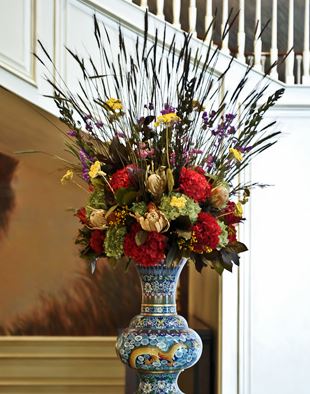 Flowers can be dried using various methods such as air drying, water drying, oven drying, drying in sand, drying with desiccants and microwave drying. There are large varieties of dried flowers available to purchase in single bunches by variety, in wreaths and in bouquets to create arrangements that show bright natural colors.
Flowers can be dried using various methods such as air drying, water drying, oven drying, drying in sand, drying with desiccants and microwave drying. There are large varieties of dried flowers available to purchase in single bunches by variety, in wreaths and in bouquets to create arrangements that show bright natural colors.
Dried flower arrangements have been popular for centuries, being most popular during winter months when fresh flowers are not available. Today, not only are dried flowers cheaper than their fresh counterparts, they are available year round and last longer. If you are new to floral design, dried flowers are a good start as they are more flexible and easier to handle than fresh flowers and foliage in a floral arrangements.
Beginner’s dried floral arrangement
For your dried floral arrangement you can be as creative as you like. Suggestions for types of dried plants to use are:
- Dried grasses, lavender, wheat or straw to fill your container.
- For dried foliage consider maidenhair fern, caspia gyp flax or galax leaves
- Large dried flowers include Hydrangeas and cockscomb
- Medium-size flowers include dried roses and straw flowers.
- To accent the overall shape, add additional fillers like larkspur or delphinium.
- Ferns can be used to fill in empty spaces.
- Dried flax adds volume and fullness
1. Use floral clay to fix your vase onto a lazy susan to help you check out the flower arrangements from all sides.
2. Force a piece of foam into the vase. Add the flowers, with bigger focal flowers first, then medium-size. Add the flowers uniformly. Accent the overall shape and fill any gaps with fern and flax.
Make a dried flower wreath
The basic materials you need for making a wreath are straw and styrofoam, wired wooden floral picks, pliers, white glue, greening pins, and floral wire.
1. Join a ring of floral wire to the wreath foundation.
2. With the wreath foundation as the base, start decorating from its outside edge with dried roses, grasses, leaves and berries and work toward the center. Cover the wreath generously with the plant materials. Overlap the stems as you go. This will result in a fuller and a more natural appearance. Attach with floral picks (wired wood picks) or white glue.
3. Having a sense of where the top of the wreath is will help you place materials uniformly. Test for completeness by keeping the wreath on a table and verifying that there is no space between the decorating material and the surface of the table.
How to make a floral headdress
Perfect for a wedding keepsake, a dried headdresses is made the same way as fresh ones, by bundling groups of flowers together and wiring them to a floral stem wire. Bows evenly spaced throughout the circle can be added to cover the hooks at either ends of the wire. Beads, pearls and feathers can be added by wiring and taping them like flowers.
1. Form the basic circle with two, twenty-three inch long, floral wires. Form hooks on the ends and bind the wire together with floral tape.
2. Use floral wire to bind up small bunches of flowers such as roses, delphiniums and gypsophila. Cover the wire with floral tape.
3. Tape the bunches to the top end of the wire, gradually building up the bunches in overlapping layers.
4. When all the bundles are attached. Hook the ends together, and conceal the hook with a ribbon.



